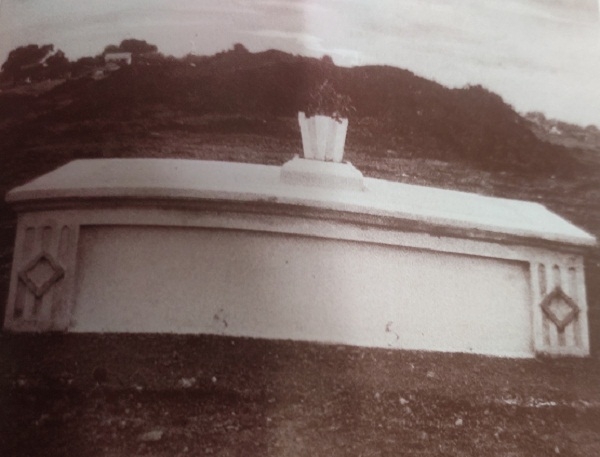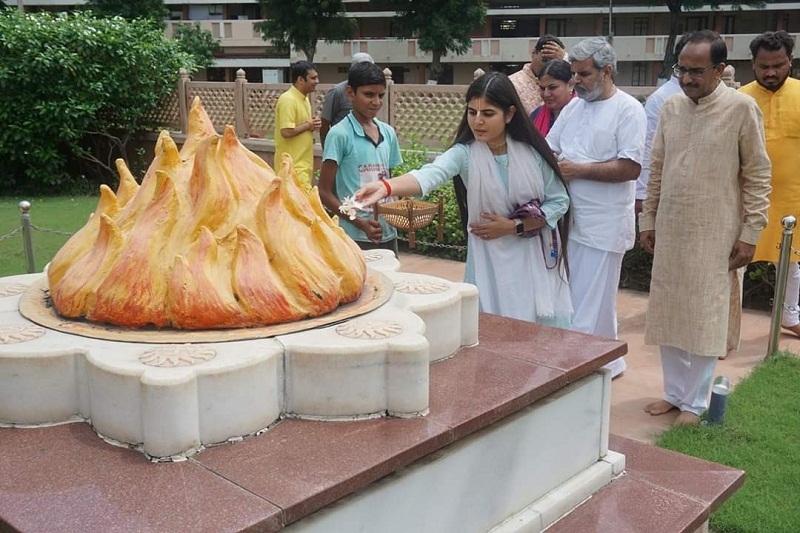Diamond Jubilee of Dr. Hedgewar Smriti Mandir

This is not a conventional temple though it is called a ‘Mandir’. Situated in Reshambag locality of Central Indian city of Nagpur this temple has become a place of attraction and reverenced for millions who keep coming to Nagpur from all directions to pay homage and tributes to the great personality to whose memory this temple is dedicated.
Yes. I am talking about the Smriti Mandir, located in Nagpur’s Reshambag locality. It is completing 60 years of inspiring presence braving the vagaries of nature all through these six decades since its inauguration on April 5, 1962. I was a school-going kid and we were living in Amravati then. But I vividly remember my father attending this inaugural function on the first day of Hindu New Year then.
Six decades ago on this date in the year 1962, a memorial in memory of Dr. Keshab Baliram Hedgewar founder of Rashtriya Swayamsevak Sangh (RSS) was inaugurated at Nagpur, the birthplace of the world’s largest Hindu organization – the RSS. This memorial came into existence over two decades after his departure from this mortal world. This event today completes its 60 years!
Popularly known as Smriti Mandir dedicated to the memory of RSS founder Dr. Keshavrao Balirampant Hedgewar today is no less than a sacred and holy place for millions of swayamsevaks and dignitaries alike who unmistakably make it a point to visit this place during their Nagpur itinerary.

The old ‘Samadhi’ of Dr. Hedgewar
The Smriti Mandir is built over the ‘samadhi’ of Dr. Hedgewar but it is a different mandir from the conventional and traditional ones. The swayamasevaks and dignitaries come and offer floral tributes to the life-size bronze statue of RSS Founder Dr. Hedgewar. The Mandir premises are not agog with the hubbub of shops selling flowers and sweats. No one can find shops selling books or any other such material which is often sold at any religious temple. This is a different temple in this sense also.
Dr. Hedgewar breathed his last on June 21, 1940, and his mortal remains were cremated on the land where this Smriti Mandir is standing now. Earlier, there was a platform over which a ‘Tulsi Vrindavan’ was placed to mark the place where his last rites were performed. However, in 1948, in the aftermath of Gandhi’s murder, a group of hooligans came and damaged this ‘samadhi’ of Dr. Hedgear. The RSS was banned then and all prominent RSS leaders and common swayamsevaks were incarcerated in different jails for the crime they never committed.
When the ban on RSS was lifted in 1949, this ‘Samadhi’ was repaired and restored and a covering hut was built with simple decoration.
Around 1955, it was thought to protect this Samadhi to save it from the vagaries of nature and accordingly some ideas were suggested in 1956 August. A Mumbai-based architect Dixit was entrusted with this responsibility. After giving much thought to it he prepared a sketch of the Smriti Mandir in 1956 October and fixed five things. (1) There will be no change in the original Samadhi place. (2) A room should be constructed to protect the Samadhi and a place statue of Dr. Hedgewar on top of it. (3) The construction would be done with stones. (4) Reasonable expenditure on beautification and decoration, and (5) The architecture should be Indian and swadeshi material be used in construction.
This was followed by the search for a suitable stone. Primarily, the search was confined to areas near Nagpur but when it was made clear that this does not have the required quality, the search was directed to the south but in vain. Finally, the basalt of Maharashtra and sandstone of Jodhpur were finalized for the ground floor and the first floor up to the peak. Architectural designs were ready by October 1956 and the famous sculptor of Mumbai Nanabhai Goregaonkar was entrusted with the job of making the bust of Dr. Hedgewar.
When the teams visited Nashik, Manmad, Sangli, etc. in search of black rock, it was noticed that this would not be useful for the purpose. Meanwhile, an artisan from Manmad suggested that the stone of Talwade village is the best for this purpose. So the team of experts went to Talwade which is situated on Aurangabad-Nandgaon road. A Pune-based architect Sri Apte made a beautiful picture of the smriti mandir and the then Sarsanghchalak Golwalkar Guruji beautified it with some of his own sketches. It was his idea to have a bow-like arch of the smriti mandir.

https://www.newsbharati.com/Encyc/2022/4/5/Diamond-Jubilee-of-Dr-Hedgewar-Smriti-Mandir.html
The work of the smriti mandir started in full swing under the supervision and guidance of the then Kendriya Karyalaya Pramukh Pandurangpant Kshirsagar, Moropant Pingle, Babasaheb Talatule, Engineer Kanvinde, Mason Ahirrao, Manohar Indapwar, Vasantrao Joshi and others of Nagpur. Around the same time, Dr. Hedgewar Smarak Samiti was established, and coinciding with the birth anniversary of Dr. Hedgewar on the Varsh Pratipada in 1959, bhumipujan of the Smriti Mandir was performed at the hands of Sri Guruji. The plinth work started in May 1959 and was completed by August end. By 1960 January ground floor work was almost done.
When the work of the first floor was to start a problem occurred. Those who were at ease with the work on the black stone were not conversant with working with Sandstone. So the search for artisans began and ended at Hakim Bhai in Rajasthan. An agreement was inked with him on December 21, 1959, and he took up the responsibility from purchasing the sandstone from Jodhpur to fixing it to the Smriti Mandir in Nagpur.
This Smriti Mandir admeasuring 1200 sq ft with 45 ft height houses the Samadhi of Dr. Hedgewar at the ground floor. The old Samadhi was given Marble decoration with stones from Kangda, Jaisalmer, Greenstone from Vadodara, Red Granite from Chamunda Hills of Mysore, and white marble from Makrana. One can have ‘darshan’ of the Samadhi from all four sides and there is also a space for circumambulation. The top of the smriti mandir sports a full-blown lotus Patel, a pot, and a ‘Kalash on the top of it.
Earlier it was decided to place the bust of Dr. Hedgewar but as the mandir was evolving it was a common opinion to have a life-sized statue. So, the present statue was prepared by the same artist and was set on the first floor of the smriti mandir on December 23, 1961. One can have the ‘darshan’ of the statue from three sides except for the back. There are steps to go up to the first floor from both sides.
Thus, the work which began in 1959, was completed in 1962. When the work was going on, there was a communal riot at Jabalpur and naturally, the 22 Muslim artisans working under Hakim Bhai’s guidance were feeling uneasy. Some of them had already left. But this was noticed by Pandurangpant Kshirsagar and he talked to them and consoled them and also assured them. In a couple of days, all of them were called at the Mahal RSS Karyalaya where Sri Guruji also talked to them in a most assuring tone. “We are satisfied with our talks with Sri Guruji”, was the reaction of Hakim Bhai. At the time of the inauguration of Smriti Mandir, Sri Guruji felicitated Hakim Bhai by presenting him with a golden ring, shawl, and a Srifal, and a citation which he had framed and put as an exhibit in his house in Rajasthan.
The inauguration ceremony of this Smriti Mandir was held on 5th April 1962 on the auspicious Varsha Pratipada Day which was also the birth anniversary of Dr. Hedgewar. Sangh workers from all over the country besides invitees had assembled at Nagpur and their staying arrangements were done at the houses of nearly 2000 swayamsevaks in a typical Sangh style. Thus, this occasion helped strengthened the Sangh Parivar and the integrity of the country.
Revered Shankaracharya of Kanchi Kamakoti Peetham was invited for this program but it was not possible for him as he would travel on foot. He had sent his blessings and ‘vibhuti’. In his message, the revered Acharya blessed the event and hoped that this memorial of Dr. Hedgewar would remind the people of his selfless and dedicated life and inspire them to devote their energies to the uplift of the nation.
Sri Guruji performed the puja of the Samadhi in a Vedic style and tradition on the morning of April 5, 1962, and offered the ‘Vibhuti’ to the Samadhi to mark the inauguration. Sri Guruji’s mother’Tai’ had come for the ‘darshan’ of the Samadhi in the afternoon. In the evening a public function was organized which was attended by swayamsevaks, invitees, and dignitaries from other states.
In his inspiring address before the gathering of swayamsevaks on the next day, Sri Guruji said that the intention of constructing this Smriti Mandir was not just to create another holy place of worship for thousands of faithful followers. I wanted this here because this place is very sacred and pious. The RSS founder put his sweat and blood into the growth of Sangh here in this land and he was cremated here. This is the most sacred place for us and it will continue to inspire us in the future. We must look at this Smriti Mandir from this point of view.
Smriti Chinh or Samadhi of Sri Golwalkar Guruji
In front of the Smriti Mandir there lies the ‘Smriti Chinha’ or Samadhi of Sri Golwalkar Guruji in the form of a ‘Yagya Jwala’ the ever-burning fire of Sangh work in the hearts of the visitors. Golwalkar too was cremated here in June 1973 after he left his mortal frame. He served the RSS for 33 years after the death of Dr. Hedgewar as per his instructions and handed over the reins of the organization to Balasaheb Devras.
Today, as the Sangh is growing with leaps and bounds, the Smriti Mandir dedicated to its founder is attracting many a dignitary from various fields of the nation’s life. They included the Dalai Lama, former President Pranab Mukherjee, Dr. APJ Abdul Kalam, former Prime Minister Atal Bihari Vajpayee, and many others. Every year, thousands of swayamsevaks who gather at Nagpur to participate in various training camps and meetings invariably visit this place and draw inspiration for their life’s mission.
(Courtesy: News Bharati)

